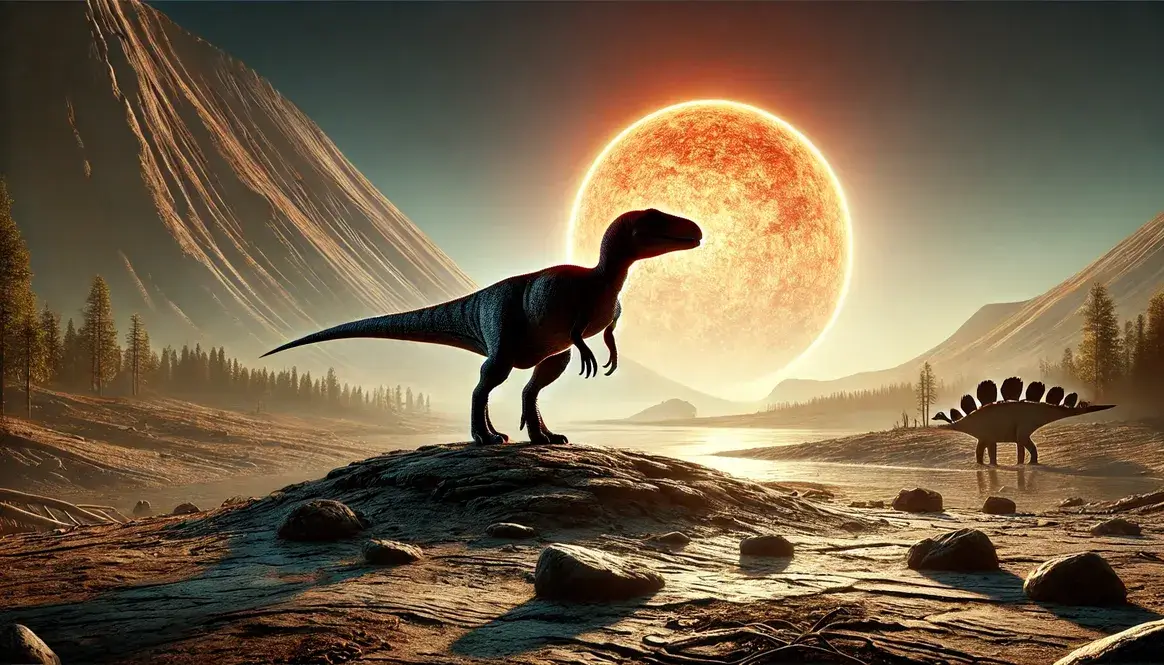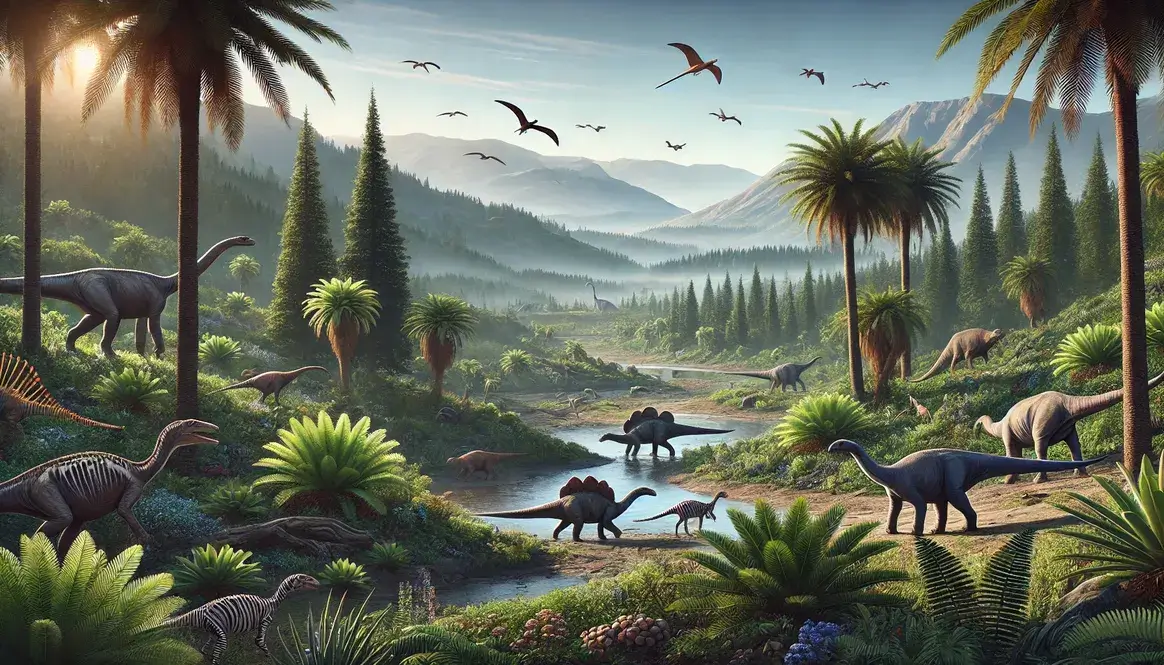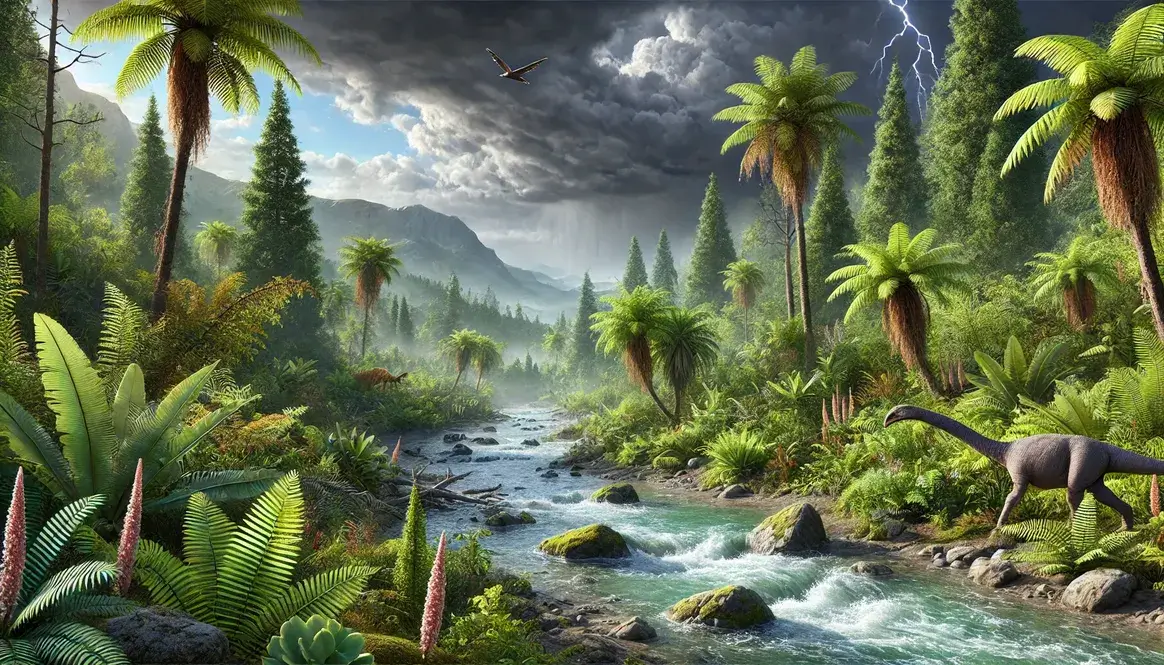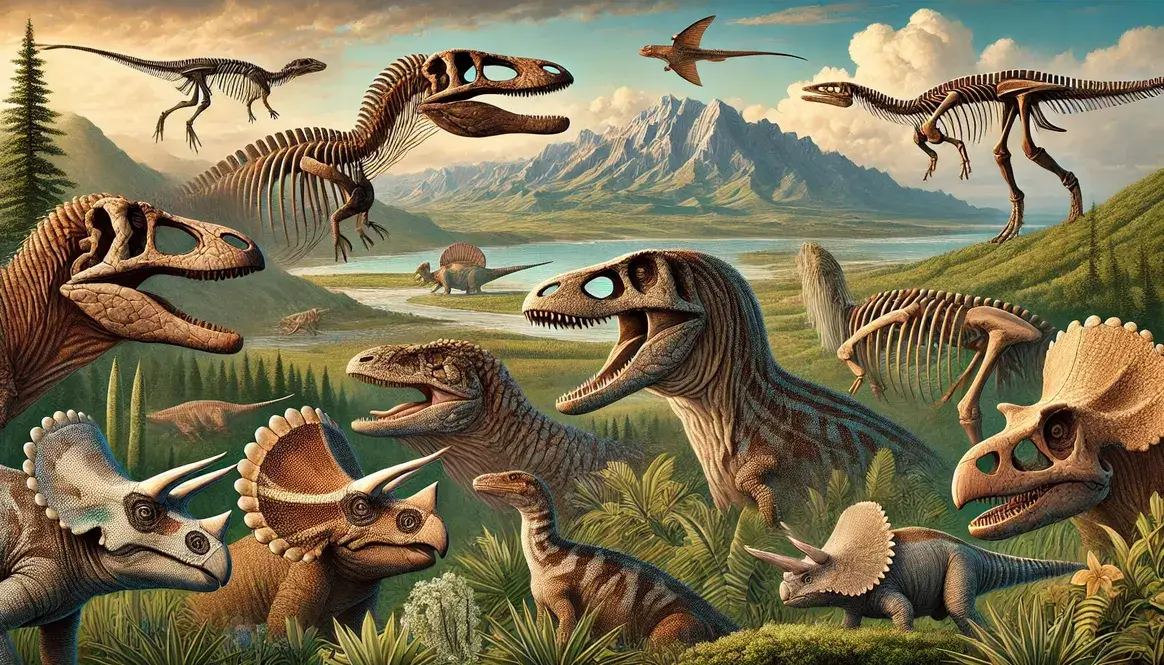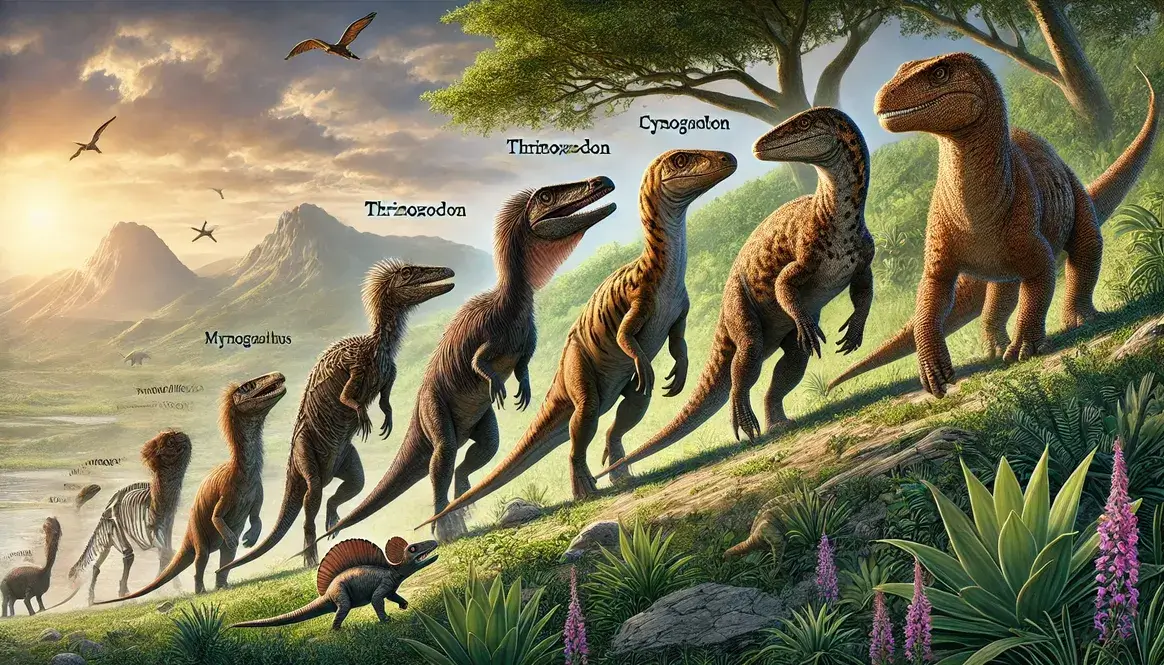Picture a world recovering from chaos. That’s what Earth looked like about 252 to 247 million years ago, during the Early Triassic period. This time marked the beginning of an incredible journey – the rise of the early Triassic dinosaurs!
After the worst mass extinction in Earth’s history (the Permian extinction), life was slowly bouncing back. The Early Triassic was like a giant reset button for our planet. The climate was hot and dry, and most of the land was smooshed together in one huge continent called Pangaea.
As life began to recover, some special reptiles started to evolve. These early Triassic dinosaurs were small but mighty, and they were about to change the world!
The Earliest Known Dinosaur Species
The quest to find the first dinosaur is like a thrilling treasure hunt through time. Scientists have uncovered fascinating fossils that give us clues about when dinosaurs first appeared on Earth. Let’s dive into the exciting world of early dinosaur discoveries and the debates that surround them.
Nyasasaurus parringtoni: The Possible First Dinosaur
Meet Nyasasaurus parringtoni, the current champion for the title of “Earliest Dinosaur.” This little guy lived about 245 million years ago in what’s now Tanzania.
Scientists found some pretty cool bones:
- A upper arm bone (humerus)
- Some vertebrae (back bones)
These fossils are super exciting, but they’re also a bit tricky. Why? Because they’re not complete. It’s like trying to solve a puzzle with most of the pieces missing!
Some scientists think Nyasasaurus was definitely a dinosaur. Others aren’t so sure. They think it might have been a dinosauriform – that’s a fancy word for an animal that was almost, but not quite, a dinosaur.
This debate is ongoing, and it shows how challenging it can be to pinpoint exactly when dinosaurs first appeared. It’s like trying to find the very first flower in a huge garden!
Other Early Triassic Dinosaur Candidates
Nyasasaurus isn’t the only contender for the “First Dinosaur” title. There are a few other Early Triassic animals that might have been dinosaurs or very close relatives:
- Asilisaurus: This little critter lived around 245 million years ago in Tanzania. It walked on four legs and might have been an early relative of dinosaurs.
- Eucnemesaurus: Found in South Africa, this animal lived about 230 million years ago. Some scientists think it might have been an early sauropodomorph (the group that later included long-necked dinosaurs).
- Agnosphitys: This small reptile from England lived around 235 million years ago. It had some dinosaur-like features, but scientists are still debating if it was a true dinosaur.
Why is it so hard to identify these early dinosaurs? Here are a few reasons:
- Incomplete fossils: Often, we only find bits and pieces of these ancient animals.
- Shared features: Early dinosaurs looked a lot like their close relatives, making it tough to tell them apart.
- Evolving definition: As we learn more, our understanding of what makes a dinosaur a dinosaur keeps changing!
It’s like trying to spot the differences between twins – you need to look really closely!
Characteristics of Early Triassic Dinosaurs
Early Triassic dinosaurs were fascinating creatures, quite different from the giant beasts that would later rule the Earth. These pioneering dinos had unique features that set them apart from other reptiles of their time and paved the way for their future success. Let’s explore what made these early dinosaurs special.
Physical Features
Early Triassic dinosaurs were not the giants we often imagine when we think “dinosaur.” In fact, they were pretty small:
- Most were about the size of a house cat or a medium-sized dog
- They typically weighed between 22 to 66 pounds (10 to 30 kilograms)
But what they lacked in size, they made up for in cool adaptations:
- Upright stance: Unlike their sprawling reptile cousins, early dinosaurs stood with their legs directly under their bodies. This made them faster and more efficient movers.
- Hollow bones: Many early dinosaurs had bones filled with air pockets. This made their skeletons lighter, helping them move more quickly.
- Long, S-shaped necks: This flexible neck helped them reach food and look out for danger.
- Specialized hips: Early dinosaurs had either lizard-hipped (saurischian) or bird-hipped (ornithischian) pelvic structures. This difference would become super important as dinosaurs evolved.
Here’s a quick comparison of early dinosaur features with their reptile relatives:
| Feature | Early Dinosaurs | Other Triassic Reptiles |
| Stance | Upright | Sprawling |
| Bone Structure | Often hollow | Solid |
| Neck | Long, S-shaped | Usually shorter, less flexible |
| Hip Structure | Specialized (saurischian or ornithischian) | Less specialized |
Behavioral Traits
Even though these dinosaurs lived so long ago, scientists have some cool ideas about how they might have behaved:
- Social butterflies? Some fossil evidence suggests early dinosaurs might have lived in groups. They probably weren’t having dinosaur parties, but they might have hung out together for protection or hunting.
- Fast movers: With their upright stance and light bones, early dinosaurs were likely quick on their feet. This speed would have been super helpful for catching prey or escaping becoming someone else’s lunch!
- Varied diets: Some early dinosaurs were meat-eaters (carnivores), while others preferred plants (herbivores). A few might even have enjoyed a mixed diet (omnivores).
- Smart cookies: While not Einstein-level smart, early dinosaurs had larger brains relative to their body size compared to many other reptiles of their time. This probably helped them adapt to different environments and situations.
Ecological Roles
Early Triassic dinosaurs were like the new kids on the block in their ecosystems. Here’s how they fit into the Early Triassic food web:
- Small but mighty predators: Carnivorous early dinosaurs probably hunted insects, small reptiles, and early mammals. They weren’t top predators yet, but they were working on it!
- Plant munchers: Herbivorous dinosaurs helped control plant growth and spread seeds through their poop (yes, dinosaur poop was important!).
- Prey animals: Being small, early dinosaurs were also on the menu for larger predators like rauisuchians (croc-like reptiles) and early crocodylomorphs.
Early dinosaurs interacted with lots of other animals:
- They competed with synapsids (ancestors of mammals) for food and territory.
- They avoided larger predators like phytosaurs (croc-like river dwellers).
- They probably ignored the first flying reptiles (pterosaurs) that appeared late in the Triassic.
As time went on, dinosaurs would become more and more important in their ecosystems. But in the Early Triassic, they were just getting started on their journey to becoming the rulers of the Mesozoic world!
Key Fossil Discoveries from the Early Triassic
The Early Triassic was a time of rebirth for life on Earth, and the fossils from this period tell an exciting story of evolution and adaptation. Paleontologists, the rock star scientists who study fossils, have made some incredible discoveries that help us understand how dinosaurs first arose. Let’s dig into some of the most important fossil finds!
Notable Fossil Sites
Early Triassic fossil sites are like time capsules, preserving clues about the dawn of the dinosaurs. Here are some of the most important locations:
- Karoo Basin, South Africa: This site is a goldmine for Early Triassic fossils. It’s given us insights into how life recovered after the great Permian extinction.
- Ghost Ranch, New Mexico, USA: While famous for later Triassic fossils, some Early Triassic remains have been found here too. It’s like a prehistoric treasure chest!
- Czatkowice Quarry, Poland: This site has yielded fossils of small reptiles from the Early Triassic, helping us understand the environment dinosaurs evolved in.
- Nanpanjiang Basin, China: Fossils found here have shed light on marine life during the Early Triassic, giving us a fuller picture of the ecosystems of the time.
These sites are super important because they help us piece together the puzzle of early dinosaur evolution. They show us:
- What other animals lived alongside early dinosaurs
- How the environment changed over time
- How different species were related to each other
It’s like having snapshots from different parts of the world during the same time period – each one adds to our understanding of the big picture!
Breakthrough Discoveries
Some fossil finds have been real game-changers in our understanding of Early Triassic dinosaurs. Here are a few that really rocked the paleontology world:
- Nyasasaurus parringtoni: We talked about this one earlier, remember? Found in Tanzania, it pushed back the date of the earliest known dinosaur-like animal by 10-15 million years!
- Asilisaurus kongwe: Also from Tanzania, this little guy showed us that the predecessors of dinosaurs were around much earlier than we thought.
- Lagerpeton chanarensis: While slightly later than Early Triassic, this Argentine fossil helped us understand how dinosaur locomotion evolved.
These discoveries have had a huge impact on dinosaur paleontology:
- They’ve extended the dinosaur family tree further back in time.
- They’ve shown us that dinosaurs evolved gradually, not all at once.
- They’ve helped us understand what features make a dinosaur a dinosaur.
It’s like finding the first few pages of a book we thought was lost – suddenly, we have new clues about how the story begins!
Evolutionary Adaptations in Early Dinosaurs
Early dinosaurs were like the first draft of a great novel – they had the basic structure, but lots of editing and refining was yet to come. These pioneering reptiles developed some key adaptations that would set the stage for dinosaur dominance in later periods. Let’s explore how these early dinos changed and improved over time!
Locomotion Advancements
One of the biggest changes in early dinosaurs was how they moved. They went from being slow, belly-dragging reptiles to swift, upright runners. Here’s how it happened:
- Development of upright posture
- Early dinosaurs evolved to hold their legs directly under their bodies, instead of out to the sides like a lizard.
- This made them more stable and energy-efficient when moving.
- Imagine the difference between a push-up position and standing up straight – which one lets you move faster?
- Improvements in running and agility
- With their new upright posture, dinosaurs could run faster and change direction quickly.
- They developed stronger leg muscles and more flexible joints.
- Some early dinosaurs even evolved a special ankle joint that acted like a spring, giving them extra bounce in their step!
These changes made early dinosaurs more successful hunters and better at escaping predators. It’s like they upgraded from an old bicycle to a shiny new sports car!
Dietary Adaptations
Early dinosaurs didn’t just change how they moved – they also evolved new ways of eating. This helped them take advantage of different food sources:
- Evolution of different tooth structures:
- Some dinosaurs developed sharp, serrated teeth for tearing meat.
- Others grew flat, grinding teeth for chewing tough plants.
- A few even had a mix of tooth types, allowing them to eat a variety of foods.
Here’s a quick comparison of tooth types:
| Tooth Type | Shape | Function | Example Early Dinosaur |
|---|---|---|---|
| Sharp, serrated | Triangle with jagged edges | Tearing meat | Early theropods |
| Leaf-shaped | Flat with ridges | Slicing plants | Early sauropodomorphs |
| Peg-like | Round and blunt | Gripping and stripping | Early ornithischians |
- Adaptations for various food sources:
- Some dinosaurs evolved longer necks to reach high vegetation.
- Others developed beaks for efficient plant-eating.
- A few may have had specialized digestive systems to handle tough plant material.
These dietary adaptations allowed early dinosaurs to fill different ecological niches. It’s like they were trying out different menu options to see what worked best!
Sensory Developments
Early dinosaurs didn’t just change their bodies – their brains and senses evolved too. These changes helped them better understand and interact with their environment:
- Changes in brain structure and size: Early dinosaurs had larger brains relative to their body size compared to other reptiles of the time. The cerebrum (the thinking part of the brain) grew larger, potentially allowing for more complex behaviors. The cerebellum (the balance and coordination center) also increased in size, helping with their new upright posture and quicker movements.
- Enhancements in vision and other senses: Many early dinosaurs developed larger eye sockets, suggesting better vision. Some may have evolved color vision, helping them find food and mates. Their sense of smell likely improved, aiding in hunting or finding plant food. Some dinosaurs may have developed better hearing, helping them detect predators or prey.
These sensory improvements gave early dinosaurs an edge in their environment. It’s like they upgraded from an old flip phone to a new smartphone – suddenly, they had access to so much more information about their world!
All these adaptations – in movement, diet, and senses – helped early dinosaurs become more successful. They were setting the stage for the incredible diversity of dinosaurs that would dominate the planet for the next 165 million years. Talk about a glow-up!
The Early Triassic Dinosaur Environment
Imagine stepping out of a time machine into the Early Triassic world. It would look very different from the planet we know today! The environment played a huge role in shaping the evolution of early dinosaurs. Let’s explore what their world was like.
Climate and Geography
The Early Triassic had a pretty wild climate: It was generally hot and dry, like a global desert. There were extreme temperature swings between seasons and the poles were much warmer than they are today – no ice caps here!
For a deep dive into the Triassic weather patterns, check out our Triassic climate article. It’s like a prehistoric weather report!
One of the coolest things about the Early Triassic was that all the continents were smooshed together into one giant landmass called Pangaea. This supercontinent had a big impact on dinosaur evolution:
- It allowed dinosaurs to spread across large areas without ocean barriers.
- It created diverse environments, from coastal regions to deep inland deserts.
- The center of Pangaea was very dry, pushing life towards the coasts.
Want to know more about this prehistoric supercontinent? Hop over to our Triassic Pangaea article. It’s like Google Maps for the dinosaur age!
Coexisting Species
Early dinosaurs weren’t alone in their Triassic world. They shared the planet with a variety of other creatures:
- Other reptiles
- Archosaurs: The group that includes dinosaurs, pterosaurs, and crocodiles.
- Rhynchosaurs: Beaked reptiles that were common plant-eaters.
- Early pterosaurs: The first flying vertebrates (but that’s a story for later in the Triassic).
- Early mammals and their relatives
- Small, shrew-like creatures that would one day evolve into all modern mammals.
- They competed with dinosaurs for resources but mostly stayed small and nocturnal.
- Marine life
- The oceans were recovering from the Permian extinction too.
- Early ichthyosaurs (dolphin-like reptiles) were swimming around.
- Bizarre creatures like placodonts (armored marine reptiles) were evolving.
For a deeper dive into the Triassic seas, swim over to our Triassic sea creatures article. It’s like “Finding Nemo” for the Triassic!
This diverse cast of characters made the Early Triassic a time of fierce competition and rapid evolution. Our early dinosaur friends had their work cut out for them!
From Early Triassic to Dinosaur Dominance
The story of dinosaurs is like a classic underdog tale. They started small in the Early Triassic but went on to become the superstars of the Mesozoic world. Let’s see how these plucky little reptiles set the stage for dinosaur domination:
- Diversification: Early dinosaurs branched out into different types: Meat-eaters (theropods), long-necked plant-eaters (sauropodomorphs) and bird-hipped plant-eaters (ornithischians). This diversity allowed them to fill different ecological niches.
- Size increase: Over time, some dinosaur lineages grew larger. By the Late Triassic, some were already reaching impressive sizes.
- Global spread: As Pangaea began to break up, dinosaurs spread to new areas. They adapted to different environments around the world.
- Outcompeting rivals: Dinosaurs’ unique adaptations helped them outperform other reptiles. By the end of the Triassic, they were becoming the dominant land animals.
The next phase of dinosaur evolution would see them:
- Grow to enormous sizes (hello, long-necked sauropods!)
- Develop amazing defensive features (looking at you, Stegosaurus)
- Evolve into a huge variety of shapes and sizes
It’s like watching the pilot episode of a TV show that goes on to run for 165 million years! The Early Triassic dinosaurs were the start of something big – literally and figuratively.
As we move into the Middle and Late Triassic, get ready for dinosaurs to really hit their stride. They’ll face new challenges, evolve cool new features, and set the stage for their golden age in the Jurassic Period. But that, dear dino fans, is a story for another time!
Remember, every mighty Tyrannosaurus rex and massive Brachiosaurus had its roots in these humble Early Triassic beginnings. It just goes to show that from small things, giants may grow – and in the case of dinosaurs, they certainly did!

